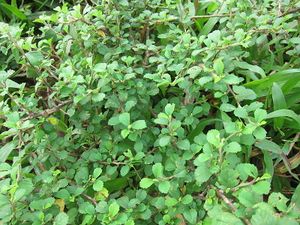Note: This is a project under development. The articles on this wiki are just being initiated and broadly incomplete. You can Help creating new pages.
Difference between revisions of "Sida rhombifolia - Devabala"
m (Jayashree moved page Sida rhombifolia to Jelly leaf) |
|
(No difference)
| |
Revision as of 11:07, 13 October 2016
Sida rhombifolia is widely distributed in the tropics and occurs in almost all countries of tropical Africa. In Niger, DR Congo and the Central African Republic it is cultivated as a fibre crop, and in India, Australia and the Americas as well.
Uses
- The bark of Sida rhombifolia yields fibres that are used in the same way as those of jute (Corchorus spp.). In Niger the fibres are used to make fishing-lines and nets and in the Central African Republic for making large hunting-nets.
- The stems are woven to produce wattle-work doors, and in Gabon and Kenya they are used for cleaning the teeth.
- The whole plants are used as brooms in DR Congo, the Central African Republic and Gabon.
- The leaves and shoots are used as a vegetable in South Africa and South America.
- In East Africa, the wood-tar of Sida rhombifolia is used as a dye and in India it is used for blackening teeth.
- The leaves are used as a soap-substitute in Gabon and Kenya.
- In traditional African medicine decoctions of the roots and leaves are widely used as emollients. The leaves or the leaf sap are applied to the skin as an antiseptic and to treat abscesses, ulcers and wounds, for instance in Equatorial Guinea, Gabon, DR Congo, Tanzania and Madagascar.
